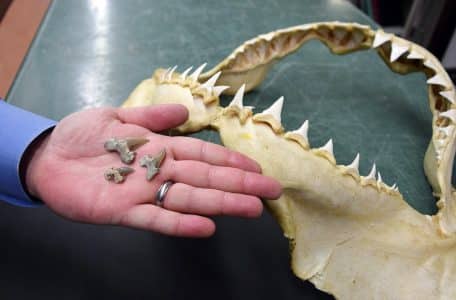Alabama scientists have discovered a new shark named for ‘Bear’ Bryant family

Jun Ebersole, Director of Collections McWane Science Center, examines teeth from the Bryant Shark. (McWane Science Center)
Alabama scientists announced today the discovery of a new species of fossil “mega-toothed” shark nicknamed the “Bryant Shark.” The new species was named in honor of one of Alabama’s most prominent families, the Bryants, which includes legendary University of Alabama football coach Paul “Bear” Bryant.
Bryant Shark a new species named for legendary Alabama football coach and his family from Alabama NewsCenter on Vimeo.
Teeth from the new species are on display in the Fossil Hall at McWane Science Center in Birmingham.

Bryant Shark exhibition. (McWane Science Center)
“The members of the Bryant family have been long-time supporters of not only the McWane Science Center, but also the Alabama Museum of Natural History,” said Jun Ebersole, director of Collections at McWane and the study’s lead scientist. “The new species honors the Bryant family’s long-standing commitment to education in our state.”
Ebersole identified the new shark species, Cretalamna bryanti, by examining fossilized teeth in the scientific collections at McWane and the Alabama Museum of Natural History at the University of Alabama. The fossilized teeth had been collected in central Alabama over 40-years.
“This shark lived during the time of the dinosaurs in the Late Cretaceous Period, roughly 83 million years ago,” Ebersole said.

Close up of several Bryant Shark teeth. (McWane Science Center)
While the teeth had been part of the museum collections for decades, “this new species had been overlooked, not recognized, or misidentified by previous scientists as other shark species,” Ebersole said. “Recognition of this new species lends further evidence that the diversity of early mega-toothed sharks was much higher during the Late Cretaceous than previously thought.”
The Bryant Shark is a member of the Otodontidae, an extinct family of mega-toothed sharks that appeared 100 million years ago. The Otodontidae family includes the largest predatory shark to ever live, the 60-foot Megalodon. These sharks are called mega-toothed due to the size of their teeth. The Bryant Shark had some teeth measuring over an inch in height.
“The teeth of the Bryant Shark are very similar to several mega-toothed shark species which survived the extinction of the dinosaurs,” Ebersole said. “Although it is not conclusive, this suggests that the Bryant Shark may be part of the direct lineage which eventually led to Megalodon.”
The article featuring this new discovery, “A new species of Cretalamna sensu stricto (Lamniformes, Otodontidae) from the Late Cretaceous (Santonian-Campanian) of Alabama, USA” was published today in the online journal PeerJ.
For additional information visit McWane Science Center.








